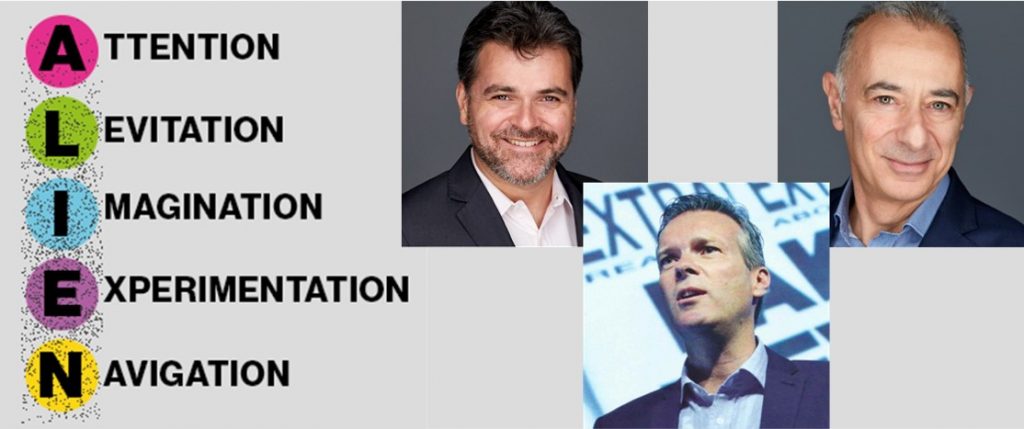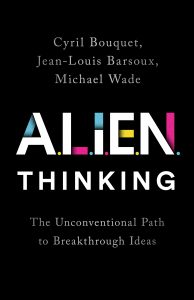Exclusive Interview Excerpt from InnovationManagement.se with Cyril Bouquet, Jean-Louis Barsoux, and Michael Wade

For the past decade, Cyril Bouquet, Jean-Louis Barsoux, and Michael Wade, professors of innovation and strategy at IMD Business School, have studied inventors, scientists, doctors, entrepreneurs, and artists. These people, or “aliens,” as the authors call them, are able to make leaps of creativity, and use five patterns of thinking that distinguish them from the rest of us.
Alien Thinking leads to a fresh and flexible approach to problem-solving. Alien thinkers know how to free the imagination so it can detect hard-to-observe patterns. They practice deliberate ways to retreat from the world in order to see the big picture underlying a problem. And they approach ideas in systematic ways that reflect the constraints of reality.
I had the opportunity recently to interview these three IMD professors about the concepts behind the book ALIEN Thinking: The Unconventional Path to Breakthrough Ideas.
Below is the text of the interview:
1. It looks like A.L.I.E.N. is an acronym. What are the key components that make up the approach? And what was the genesis for its creation?
Cyril Bouquet (CB): ALIEN thinking is first and foremost a metaphor that captures the need to approach problems with an open mind and a fresh perspective – like a child or an outsider – in order to develop breakthrough solutions.
About 10 years ago, my colleague Estelle Metayer (now professor at McGill University in Canada) was discussing the importance of avoiding strategic blindspots in a session she ran for groups of executives at IMD. Browsing through a book on change called Future Think, she also brought my attention to the first chapter, which was called “Looking Through Alien Eyes”. I thought this metaphor was very applicable to innovation – and at some point, I made a connection between the letters and some of the themes I was teaching to executives in class. Together with my colleagues, Jean-Louis and Mike, we came up with an acronym that highlights the essence of the creative mindset that we believe executives must embrace.
So, A stands for Attention, which is about noticing problems or opportunities that you and others previously missed by changing where and how you look.
L is for Levitation, which means stepping back to gain perspective and make sense of what you’ve seen to reflect on what you need to do differently.
I stands for Imagination, which involves connecting the dots in new and interesting ways to create original and useful ideas.
E is about Experimentation, which is about testing your promising idea and turning it into a workable solution that addresses a real need.
Finally, N stands for Navigation, which is about finding ways to get your solution accepted without getting shot down in the process.
2. Why is originality important? Why is it difficult to be original?
Jean-Louis Barsoux (JLB): Originality is a key driver of innovation and progress. It’s what fuels economic growth and brings advances in domains from science and medicine to inequality and sustainability, not to mention spiritual and emotional sustenance through the creative and performing arts.
But originality often represents a challenge to the prevailing norms and practices. It can easily trigger an allergic reaction toward the “odd” idea or its “weird” originator. The more disruptive your idea, the harder you need to work to show how it fits with the belief systems of people whose support you need to move the idea forward.
This is especially the case within companies. Intrapreneurs who come up with breakthrough ideas are often shocked to discover how much resistance they elicit from inside the organization that stands to benefit the most.
3. What does it mean to think like an “alien”?
Michael Wade (MW): Urging would-be innovators to think like aliens is similar to what Zen Buddhists call adopting the “beginner’s mind”. It’s about developing an attitude of openness and overcoming the many biases and blindspots that place artificial limits on your creative intelligence.
Perhaps the most insidious of these biases is what the French call “déformation proféssionnelle”. This is your tendency to look at the world through the distorting lens of your job, your training or profession. The very expertise that can help you solve problems can blind you to a wider range of creative possibilities. Instead of seeing the world as it is, you view it in the way an accountant, lawyer, engineer, or professor would see it.
This expertise baggage is problematic because it can impact every phase of the innovation process: starting with what problems we pay attention to or ignore; and how we interpret the information. It influences the types of ideas we generate and what aspects we stress or neglect in testing. Ultimately, it also impacts who we reach out to for support and what arguments we put forward to convince them.
It is vital to be conscious of this conditioning as we develop our ideas, test them, and try to sell them. Whenever possible we need to get input from people who think differently from us – and make sure we listen to them – to counteract our preconceptions.
4. Why do existing innovation frameworks – including design thinking and lean startup – fall short?
CB: The design thinking and lean start up methodologies have done a wonderful job of raising our understanding of innovation and creating a shared vocabulary – with concepts like “minimum viable product”, ideation, and pivot. But we feel that like other innovation frameworks, they fall short in two ways.
First, they are incomplete. They don’t explicitly take account of the vital role of reflection – what we call levitation – throughout the innovation process. Instead they emphasize speed and action, presenting innovation as a series of sprints. Lean startup takes the initial problem as a given, leaving no space for reframing it, before launching into a frenzied cycle of build-measure-learn. Nor do existing models integrate the digital aspect of innovation or show how digital technologies relate, say, to the “human-centric” principles enshrined in design thinking.
Second, existing models are misleading because they gloss over the psychological pitfalls and biases that inhibit your original thinking. They tell you what to do, without acknowledging why it’s difficult. For example, pivoting is a great concept, but to do it, you must overcome some critical cognitive biases, including confirmation biases and sunk cost effects. By contrast, ALIEN thinking surfaces some of the ways we deceive ourselves at different stages of the innovation process – and end up focusing on the wrong problems, or jumping to solutions, or sticking too long with a bad idea.
Our view is that an alien mindset can support and complement design thinking and lean startup by helping to challenge assumptions that these frameworks take for granted.
5. What can or should be the role of digital augmentation be in innovation activities?
MW: Digital technologies can boost ALIEN thinking in several ways – but especially during the attention and experimentation phases.
For example, in terms paying attention to how products or services are actually used and what are some of the unmet needs, we traditionally relied on painstaking direct observation of users. But today, a lot of that observation can be automated. You can remotely monitor people and objects in close to real time through sensors and social listening. For example, the German-based Nivea brand tapped into discussions across social media sites concerning deodorant use. Contrary to expectations, they discovered that the main preoccupation of consumers was not fragrance or effectiveness, but clothes stains. This insight triggered the development of a new category of anti-stain deodorants. Digital tools enable you to collect data without direct observation and on a much larger scale than previously.
Digital technologies also make a dramatic difference at the experimentation stage. You can build digital twins of objects to experiment quickly, safely, and cheaply. This is exactly what Bertrand Piccard’s team did when they built the first solar-powered plane, with the wingspan of an Airbus, the weight of a car and the power of a small motorcycle. Testing multiple full-scale prototypes would have been ruinously expensive. But computer simulation creates the possibility of trial without error – or at least without costly errors.
 6. In an era of digital saturation and burnout, how are people supposed to make time to focus and elevate their thinking?
6. In an era of digital saturation and burnout, how are people supposed to make time to focus and elevate their thinking?
JLB: Occasionally stepping back from the action to regain perspective and make sense of disparate pieces of information is vital to creativity. Reflection is an integral part of the innovation process – whether it’s to reconsider the problem, or your approach to it – or the solution itself.
But elevating your thinking, which we call “levitation”, has become increasingly difficult in a context where we are inundated with calls, emails, and texts from colleagues expecting quick responses.
Paradoxically, the experience of working from home, which should have given us more control over our agenda, has often exacerbated the problem, with back-to-back or even overlapping zoom calls. And although we save on commuting time, we rarely make use of that time to re-energize or re-assess.
The only way to secure reflection time is to plan for it. This may seem forced, but unless you schedule breaks, you will find that the demands of the problems at hand always win out. It also has to be a meaningful break. Snatching a short lunch at your desk while watching social media for distraction won’t help. Nor does going out a walk and taking your phone with you.
Creativity demands introspection. To leverage your pause, you really need to unplug and see where your mind leads you. You need to protect your boredom! Is it any wonder that people often report getting their best ideas in the shower? It is one of the few mindless activities that remains beyond the reach of digital technology!
Click to read the rest of the interview on InnovationManagement.se

![]() Sign up here to get Human-Centered Change & Innovation Weekly delivered to your inbox every week.
Sign up here to get Human-Centered Change & Innovation Weekly delivered to your inbox every week.
Pingback: Changing Your Innovator’s DNA | Human-Centered Change and Innovation